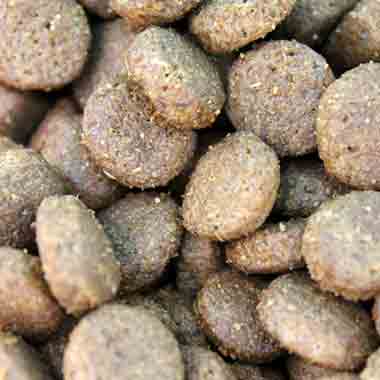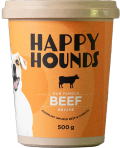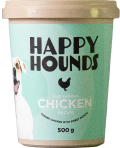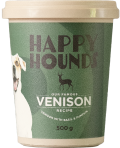Shop
For small hounds (2–10 kg)
For medium hounds (10–20kg)
For large hounds (20–40kg)
- All
- Trial Pack
- fresh food
- Treats & Toppers
- Gifts & Goodies
For small hounds (2–10 kg)
For medium hounds (10–20kg)
For large hounds (20–40kg)

The History Of Kibble
June 27, 2023 3 min read
Welcome back to the HH blog – we hope that you are enjoying learning with us. While last time we were learning ancient history and modern physiology, today we are talking more-recent history and, importantly, economics.
In order to understand most things, it can be helpful to understand where they come from. And dog food is no different. It was only in 1860 that James Spratt, an American electrician living in England, became the first business to make and sell a dog food biscuit. Before then, dogs were scavengers or were fed from the human kitchens and factories of the time. His “meat biscuit for the feeding of dogs” was the first attempt to create a commercial market for dog food and the first advertising of a patented “scientifically blended dog food”. And the market responded enthusiastically to a long-life, ready to serve pet meal. Where there is a market, there is growth and more biscuit products entered the market, but with no robust research proving nutritional adequacy.
Fast forward to 1922 when the first canned dog food was invented. Called Ken-L Ration, it was made from cleverly marketed “lean, red meat”, which was actually, if one examined the can very closely, horse meat – a very cheap and available protein with the end of WWI and the global uptake of cars and tractors. It is from these opaque beginnings that dog food became an industry known for (in some cases, very) profitably using by-products and being less than forthcoming about their ingredients. Despite the “mystery meat”, consumers loved the convenience and by 1941, canned dog food accounted for 90% of the dog food market in the USA.
During WWII metal was being directed to create munitions and many foodstuffs were redirected for human rations, so pet food manufacturers went looking for alternative packaging and more readily available ingredients. And the industry swung back to dry dog food, finding economic solutions for their packaging and ingredient shortages in the cereal industry.
It was in 1956 that Purina produced the first dry kibble through extrusion – a process used to make large quantities of shelf-stable foods and one Purina was already using to produce cereal.
|
WHAT IS EXTRUSION?
|
|---|
|
Wet and dry ingredients are mixed together to create a paste. This paste is fed through a machine called an expander where it is heated under extremely high pressures and temperatures (usually with steam or hot water). The processed paste is then extruded (pushed) through a die cutter to make the shapes we associate with kibble today.
|
The use of extrusion to mass produce dog food gained a lot of momentum throughout the 1950s, 1960s and 1970s. In 1973, American pet owners spent some $1.9 billion for more than 150 varieties of pet food and dog food sold in grocery stores totalled $1.1 billion.
Marketing campaigns taught pet owners to feed kibble and created trust in this fast food for dogs. Yet, pet food production was still a nutritional guessing game until the National Research Council in the USA created the first nutrient profiles for dogs and cats. These were further refined in 1990 into two separate profiles for dogs (one for growth and reproduction and one for adults), creating a guideline for manufacturers’ claims to be measured against. It was also around this time that experts noted the need for the high heat- and high pressure-processing techniques to be evaluated for nutrient loss and nutrient absorption challenges. Since then, a growing body of research (see below) is demonstrating the increased risks that highly-processed foods pose to our hounds’ health (allergies and dread diseases) and happiness as well as to the planet (a subject for another day).
There is no arguing with the convenience of kibble. We have been taught over decades to prioritise convenience over health and wellbeing, to effectively feed our dogs fast food. Today, highly-processed foods make up nearly 100% of the diets of our pet cats and dogs. We are all learning about the negative health impacts of a fast food diet for humans (anyone else watch Super Size Me?) so why would we choose that for our best friends?
References
- https://pubmed.ncbi.nlm.nih.gov/16013542/
- https://www.ncbi.nlm.nih.gov/pmc/articles/PMC6127788/
- https://www2.helsinki.fi/sites/default/files/atoms/files/poster_metabolomics_from_a_diet_intervention_in_atopic_dogs.pdf
- https://www2.helsinki.fi/en/researchgroups/dogrisk-health-via-nutrition-epidemiology-and-cancer-detection-dogs


20% Off When You Re-fur a Friend
Get 20% off on your next online order when a friend makes their first purchase using your personal re-furral code. Bonus, they get 20% off on their first purchase too!






